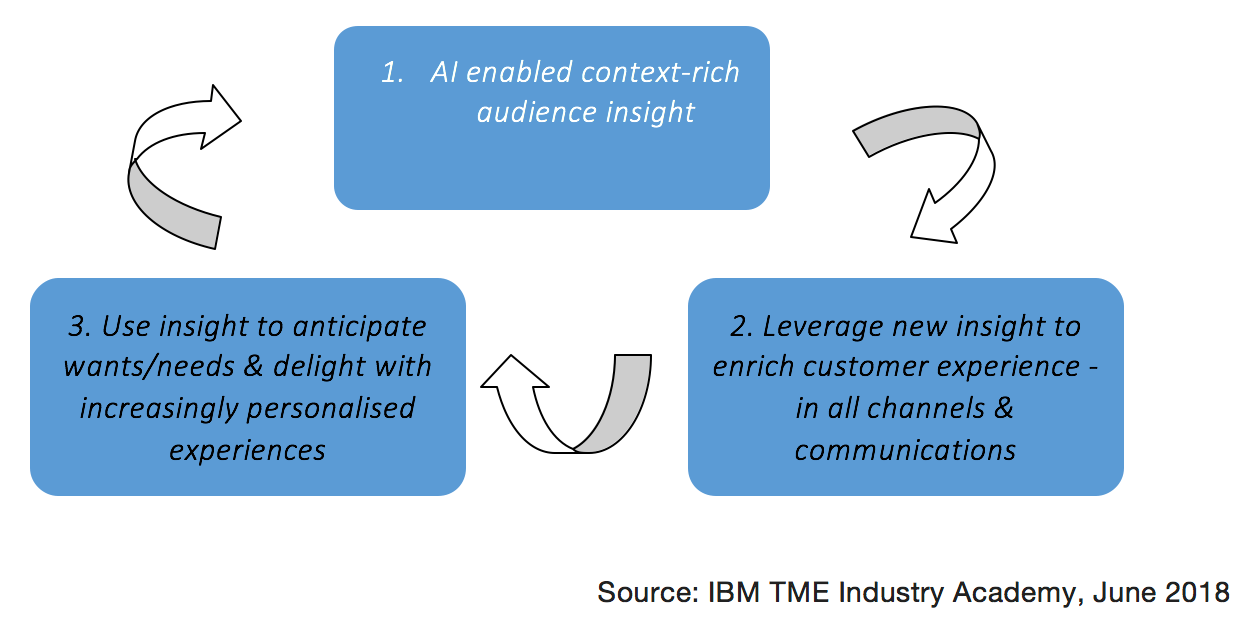Telco Media and Entertainment
AI can help media companies gain competitive edge. It’s do or die!
17 September, 2018 | Written by: Ali Davis
Categorized: Telco Media and Entertainment
Share this post:
Fundamentally, media and entertainment companies thrive by engaging audiences. However, in a world where, on average, adults check their phones 150 times per day, a frequency that rises to 300 times for teenagers* (*Director TV Personalisation, Sky UK, Sept 2018), true engagement – where the audience is invested in the experience and keen to return – is increasingly hard to come by. This issue is magnified by the explosion of means by which audiences can access content and indeed, switch between platforms, formats, brands and channels. And that’s without the disruption of voice based interaction, which I believe is going to grow at scale over the next 6 – 12 months.
Media & entertainment companies are attempting to tackle this attention deficit by scrutinising data on who their customers are, and tailoring their offering to broadly defined customer segments. However, it is well documented that the amount of data available to provide this insight is growing at an exponential rate. This is compounded by the amount of unstructured data available – images, texts, speech – that traditional computers couldn’t analyse. Alongside this, IBM’s Institute for Business Value estimated in January 2018, that up to 80% of the world’s data is unstructured – which in essence, means data driven decisions are being made with only 20% of the picture.
From the perspective of media & entertainment organisations, this means you are trying to engage an audience with a fraction of the insight. By applying AI, organisations can now garner a deep, real-time understanding of their audiences, including all of those attributes that affect our behaviour in any given moment, from the time of day, the weather, recent news, social media sentiment etc. In my opinion, those in the media and entertainment industry that turn a blind eye to this new level of understanding, that will drive a paradigm shift in audience engagement, will face increasing disintermediation and ultimately obsolescence.
However, question marks remain around how best to incorporate AI and apply it most effectively to increase customer engagement. Our experience tells us that there are three priority areas of focus which form a virtuous.

Increasing audience ratings with AI enhanced audience insight
In Japan, IPTV provider NTT Plala, Inc. used insights on viewing patterns to drive higher viewership and deeper engagement. The company dug dig deep into its viewers’ demographics, viewing habits and billing patterns for correlations and clusters that had been invisible to its marketing and service development teams.
The teams are now using these insights, combined with external data e.g time of day, and weather, to make personalized recommendations to drive higher viewership and are taking proactive steps to boost satisfaction.
The effect was a 150% increase in audience ratings, 21% Increase in customer retention rate through proactive intervention based on churn predictors and 80% Reduction in analysis cycle, improving employee productivity and enabling faster reaction to analytical findings.
Deepening audience engagement & improving conversion rates in all channels
Another company that has utilized AI to provide more engaging experiences in their digital channels, and alleviate the overwhelming paradox of choice e-commerce often presents, is VF Corporation – owner of North Face. Using artificial intelligence provided by Fluid and powered by IBM’s Watson cognitive computing technology, North Face’s online customers experience a more engaging, personalized and relevant shopping experience. The interactive tool, powered by an AI assisted bot, acts as a digital brand expert, helping users navigate the online experience like a sharp in-store sales associate.
Delighting customers and engendering loyalty by providing AI based relevant, personalised experiences
IBM Watson Media and IRIS.TV, a cloud-based personalised video programming system have launched, this week, Video Recommendations, a new AI based content personalisation engine designed to help publishers boost viewer engagement through highly relevant video programming recommendations. By combining viewer data with a deep understanding of specific elements within video, publishers are better able to predict and deliver captivating content— increasing consumption growth, building audience loyalty, and driving advertising revenue.
With a recent Gartner study predicting that by 2020, 85% of the relationships between brands and consumers will be conducted without human interactions, and research by Resulticks finding that when it comes to technically implementing AI, 69% of brands’ performance were rated as ‘poor’, while 42% had either no plans to implement, or had already aborted their efforts, this is one topic you cannot afford to ignore.
Related Article: Artificial Intelligence: a Step Change in Customer Engagement
Don’t miss out on our webinar
These are just a couple of examples of how AI has helped media businesses gain a competitive edge – from creating new customer experiences to improving personalisation to boosting customer loyalty. If you’d like to learn more, check out the webinar below where we discuss how companies can find new ways (including AI) to engage customers, address the challenge of commodity markets and industry convergence. It is also an invaluable look on how to get AI right and the common pitfalls to avoid.

Lead Industry Solutions Consultant, Telco, Media & Entertainment
Transforming B2B Sales: Unleashing the Power of AI and Automation in Telecommunications
In the dynamic world of telecommunications, staying ahead requires constant innovation. VMO2, a renowned leader in the field, recently embarked on a journey to evaluate latest technology as an opportunity to enhance end-to-end customer experiences and automate low-value tasks within their B2B sales process. The aim was to achieve time and cost savings, while improving […]
Achieving sustainability ambitions with IBM AI technology
I recently attended The Economist Sustainability Week where I had some interesting conversations with other Heads of Sustainability. The one common thread was the belief that there’s never been a more pressing time for urgent, effective action to achieve our sustainability ambitions. We are at a critical juncture. Stakeholders are demanding a greater commitment to […]
Streamlining Life Sciences Research: Simplifying Data Access with Design Principles
Life Sciences research and development is complicated: complex tasks are carried out in an environment of big data, specialised technology and regulated processes. The challenges of this complexity risks making processes and interactions iterative, slow and expensive. To accelerate innovation in the development of safe and effective treatments, Life Sciences organisations need to cut through these challenges […]

